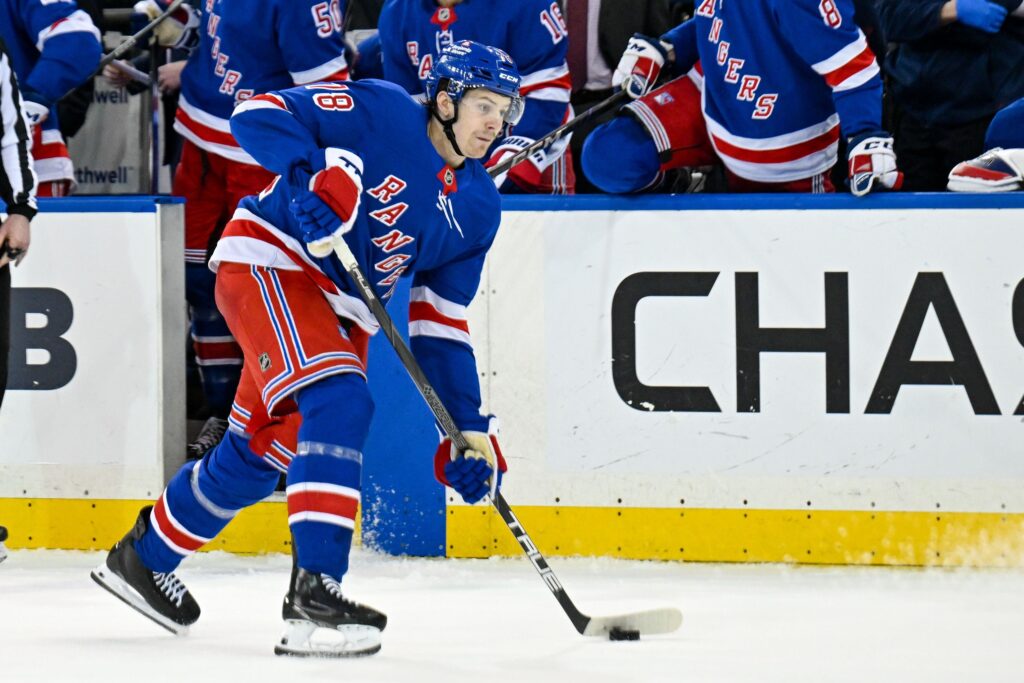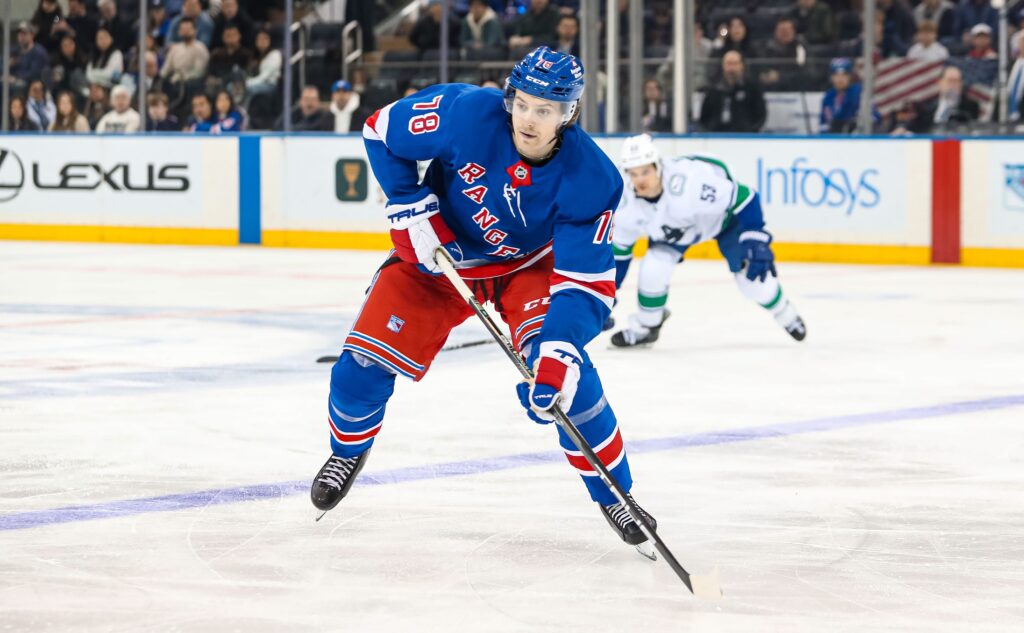When a respected voice like Elliotte Friedman reports that trade conversations are “gaining traction,” the hockey world takes notice. The subject of this mounting speculation is Brennan Othmann, the New York Rangers’ 2021 first-round pick, and the reasons behind the chatter paint a complex picture of a talented prospect at a critical juncture with a contending organization. For a team built to win now, the clock is ticking, and for a player struggling to find his footing, a change of scenery may be the inevitable conclusion.
Also on the EDGE – Metropolitan Mayhem: A Division of NHL Contenders, Pretenders, and Pain
A Stalled NHL Arrival
The primary catalyst for the trade rumors is Othmann’s inability to carve out a permanent niche on the Rangers’ roster. After being assigned to the AHL’s Hartford Wolf Pack to start the 2025-26 campaign, it marked the third consecutive season the former No. 16 overall pick has begun his year in the minors. For a player of his draft pedigree, this is not the expected trajectory.
This year’s training camp was particularly telling. Othmann entered with a legitimate opportunity to seize a bottom-six forward role, a position seemingly ripe for the taking. However, he was reportedly surpassed on the depth chart by two contrasting players: Noah Laba, a younger and more recent draft pick, and Conor Sheary, a veteran in camp on a professional tryout. To be outplayed by both a rising prospect and a seasoned vet fighting for his career sent a clear message about where the organization felt Othmann’s game stood in relation to NHL readiness.

His performance at the highest level, when given the chance, has been inconsistent. While Othmann has proven he can produce in the AHL—posting a respectable 21 goals and 49 points in 67 games with Hartford in 2023-24—that offensive touch has yet to translate. In 22 NHL games spread across the prior two seasons, he has managed just two assists while playing primarily on the fourth line. More concerning for a player whose calling card is goal-scoring, he remains without a single goal in 25 career NHL contests. The disconnect between his minor-league production and his NHL impact is becoming increasingly difficult to ignore.
Beyond the Scoresheet: Developmental Hurdles
The decision to return Othmann to Hartford wasn’t merely about a lack of production; it was rooted in a need for fundamental development. Head coach Mike Sullivan provided a clear diagnosis, explaining the assignment was designed to help the young forward refine the less glamorous aspects of his game. “Attention to detail defensively, away from the puck,” Sullivan noted, was a key area for improvement. The coaching staff wants to see him add “more detail around those things” to become a more complete, 200-foot player—a prerequisite for earning trust and minutes on a contending team.
The preseason offered a microcosm of Othmann’s developmental state. Reports indicated that his confidence “ebbs and flows.” Against his peers in rookie games, he was a dominant force, showcasing the skill and offensive instincts that made him a first-round talent. However, when facing more experienced NHL competition, that effectiveness waned significantly. This inconsistency suggests a player who has yet to build the habits and all-around game required to consistently impact play against the world’s best. For a coach like Sullivan, predictable, reliable play is paramount, especially in the bottom half of the lineup.
A Contender’s Calculus
From the Rangers’ perspective, this situation is less an indictment of Othmann’s ultimate potential and more a reflection of their own organizational timeline. General Manager Chris Drury has constructed a roster with a veteran core, designed to compete for a Stanley Cup in the immediate future. In this “win-now” environment, the luxury of patiently waiting for a prospect to round out their game is one the team simply cannot afford. The priority is immediate contribution, not long-term projects.
Furthermore, Othmann finds himself caught in a classic roster log-jam. The Rangers are deep on the wings, with established players like Artemi Panarin and emerging physical presences like Will Cuylle, Jonny Brodzinski, and Adam Edstrom occupying spots. Breaking into that group requires a player to either possess elite, undeniable offensive skill or provide a reliable, defensively sound, physical game. At present, Othmann hasn’t consistently demonstrated either at the NHL level, making him the odd man out. Drury’s exploration of the trade market is therefore a logical exercise in asset management: leveraging a prospect’s development value to acquire a piece that can help the team today.
Previously on the EDGE – 5 Burning Questions for the New-Look New York Rangers
The Path Forward: A Fresh Start and Diminishing Returns
Friedman’s suggestion that Othmann “simply may be that he needs a fresh start elsewhere” encapsulates the situation perfectly. If Rangers management has concluded that Othmann is unlikely to reach his ceiling in their system and on their timeline, it becomes Drury’s responsibility to maximize his value on the trade market.
A trade could be mutually beneficial. Othmann would land with an organization likely able to offer him a greater opportunity and more developmental runway, while the Rangers could acquire an asset—be it a roster player for a specific role or a draft pick—that better aligns with their current objectives.
However, the question of Othmann’s trade value is complex. His first-round pedigree is now, as one source noted, “muddied with his lack of progress.” He is no longer a blue-chip prospect with boundless potential in the eyes of rival GMs; he is a player with legitimate question marks. Should the Rangers opt to trade him for a draft pick, the return would likely be a second-round selection at best, a significant depreciation from his original draft slot.
This scenario is not without precedent in New York. Last season, the Rangers moved on from another first-round pick, Kaapo Kakko, sending the 2019 No. 2 overall selection to the Seattle Kraken. That move signaled Drury’s willingness to cut ties with high-profile draftees who fail to integrate into the team’s core. As the trade chatter around Brennan Othmann continues to build, it appears another difficult decision on a promising but unfulfilled young talent is rapidly approaching.
Created with the aid of Gemini AI
